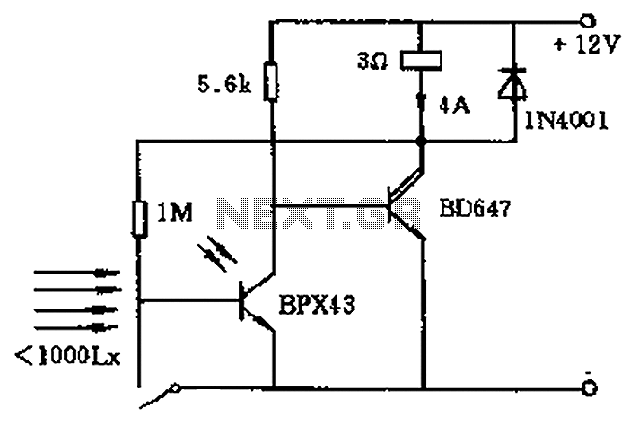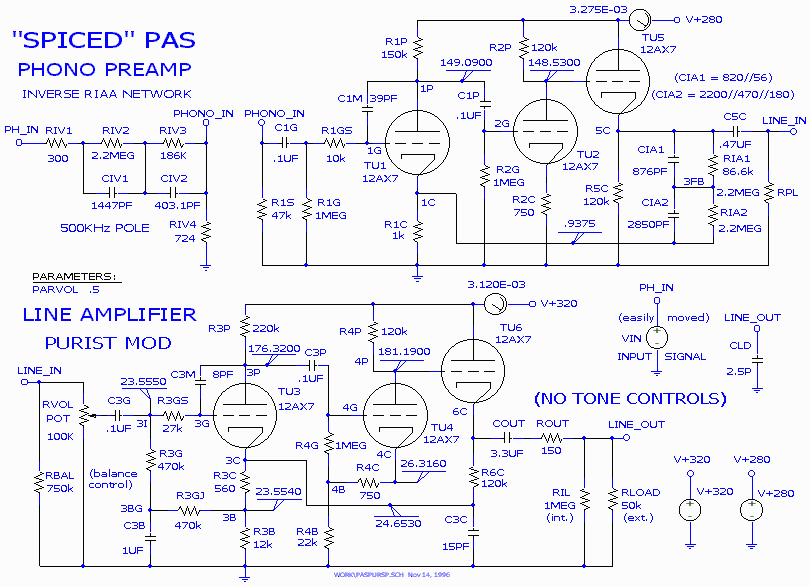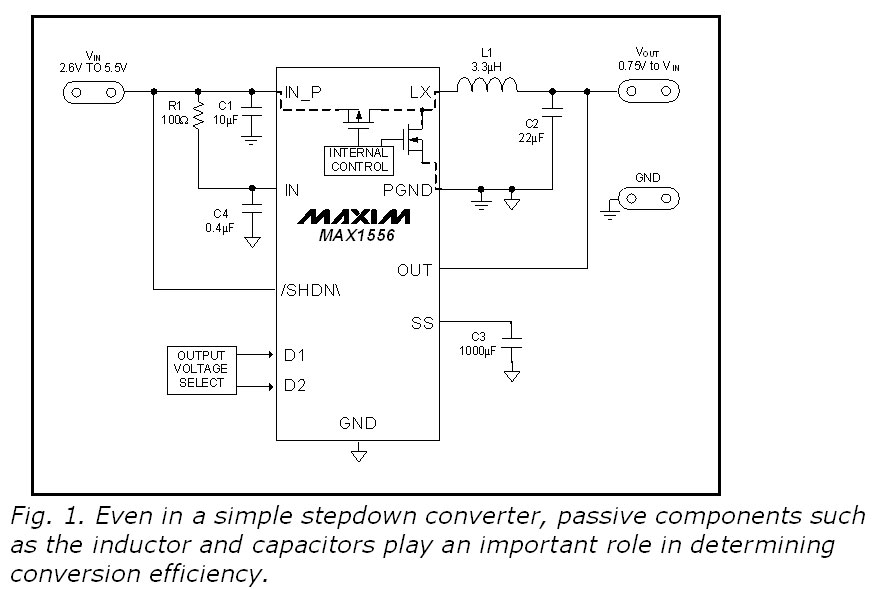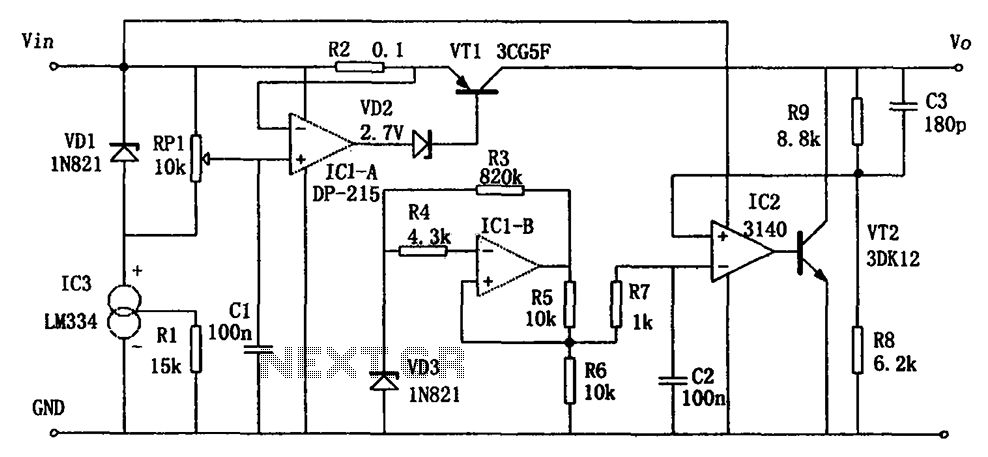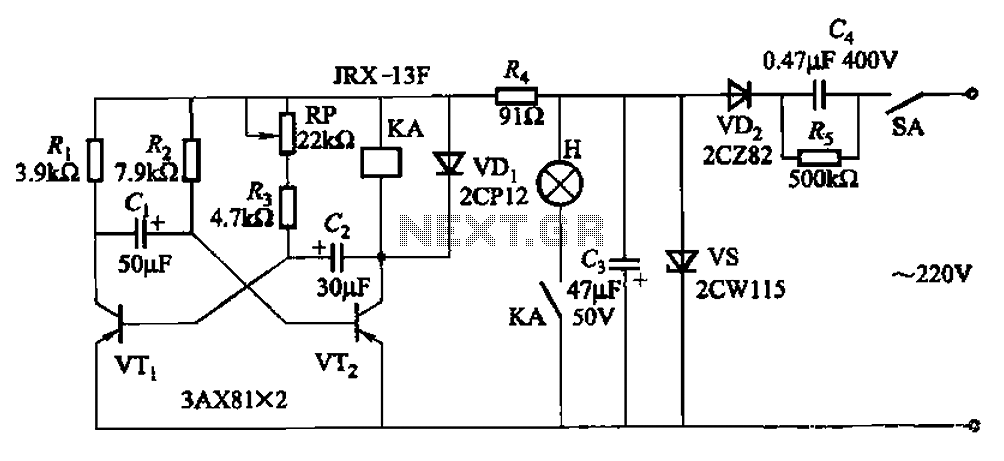
Simple home audio power amplifier circuit schematic
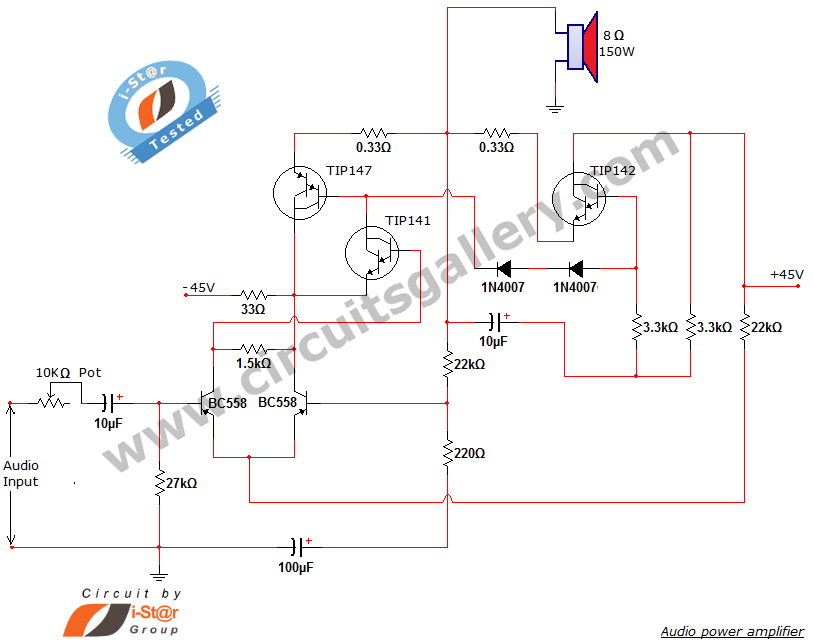
This document presents a new audio power amplifier schematic utilizing TIP darlington pair transistors. It is suitable for both home audio and car audio amplifiers. The TIP142 and TIP147 darlington pair transistors create a push-pull high-power amplifier configuration, while two BC558 PNP transistors serve as a mini audio preamplifier. The audio signal is fed into the preamplifier through a capacitor, which then couples the signal to the push-pull power amplifier via the TIP141 transistor. Component values and ratings for the power amplifier design are provided in this article. The implementation cost of this mini audio amplifier circuit is approximately $5, and it can deliver 150 W RMS to an 8-ohm load. This audio power amplifier project is based on TIP142 and TIP147, which are complementary darlington pair power transistors capable of handling 5 A current and 100 V. The two PNP transistors (BC558) form a preamplifier section preceding the high-power push-pull amplifier built around the TIP141, TIP142, and TIP147 transistors. The use of two PNP transistors for the preamplifier section constitutes a differential amplifier that enhances the overall performance of the amplifier by reducing noise. The input signal is applied to the differential amplifier section via a 10 µF DC decoupling capacitor, which eliminates the DC voltage from the input audio signal. A complementary class AB push-pull power amplifier stage is constructed around the TIP darlington pair transistors to drive an 8-ohm, 150-watt speaker. A +/-40V, 5A dual power supply is required to power this simple amplifier circuit, and a 30V-0-30V step-down transformer should be used to create a dual lab power supply for the project.
This audio power amplifier circuit is designed for high efficiency and low distortion, making it suitable for a variety of audio applications. The TIP142 and TIP147 transistors are selected for their high current gain and ability to handle significant power levels, which are essential for driving larger speakers effectively. The push-pull configuration allows for better performance in terms of linearity and reduced crossover distortion, which is particularly important in audio amplification.
The preamplifier stage, formed by the BC558 transistors, plays a crucial role in amplifying the weak audio signal before it reaches the power amplifier stage. This differential amplifier configuration enhances the signal-to-noise ratio, ensuring that the audio output remains clear and free from unwanted noise. The 10 µF DC decoupling capacitor is vital in blocking any DC offset present in the audio signal, which could otherwise affect the performance of the amplifier.
The power supply requirements of +/-40V at 5A ensure that the amplifier can deliver its full rated power without distortion. The specified 30V-0-30V transformer is suitable for providing the necessary voltage levels for the dual power supply, allowing the amplifier to operate efficiently under various load conditions.
Overall, this audio power amplifier schematic represents a cost-effective and efficient solution for audio amplification needs, making it an excellent choice for hobbyists and professionals alike. The detailed component specifications and circuit design ensure that users can replicate the circuit with ease, achieving high-quality audio performance in their applications.Here is a new audio power amplifier schematic built around TIP darlington pair transistors. You can use this circuit for home audio power amplifiers and car audio amplifiers. The TIP142 and TIP147 darlington pair transistors forms a push pull high power amplifier configuration while the two BC558 PNP transistor provides a mini audio pre amplifier circuit. The audio signal is applied to the pre amp through a capacitor, then it is coupled to the push pull power amp via TIP141 transistor. The values and ratings of different components of power amplifier design are also given in this article.
Implementation cost of this mini audio amplifier circuit is too cheap, near $5. The circuit can deliver 150 W RMS to a 8 © (150 Watt power amplifier). Our new audio power amplifier project is based on TIP 142 and TIP 147 (complementary darlington pair power transistors which can handle 5 A current and 100V). The two PNP (BC 558) transistors forms a pre amplifier section to the preceding high power push pull amplifier built around TIP141, TIP 142 and TIP 147 darlington pair transistors.
We are using 2 PNP transistors to form a preamplifier section, it is nothing but a differential amplifier to improve overall performance of the amplifier. The application of a differential amplifier in the input phase reduces noise. Input signal is applied to the differential amplifier section via 10 µF DC decoupling capacitor. Capacitor removes the DC voltage from the input audio signal. A complementary class AB push pull power amplifier stage is built around the TIP darlington pair transistors to drive the 8 © 150 watt speaker (The circuit can deliver 150 W RMS to a 8 ©).
+/-40V, 5A dual power supply is necessary to provide supply for this simplest amplifier circuit. Use 30V-0-30V step down transformer and construct a dual lab power supply for this project. 🔗 External reference
This audio power amplifier circuit is designed for high efficiency and low distortion, making it suitable for a variety of audio applications. The TIP142 and TIP147 transistors are selected for their high current gain and ability to handle significant power levels, which are essential for driving larger speakers effectively. The push-pull configuration allows for better performance in terms of linearity and reduced crossover distortion, which is particularly important in audio amplification.
The preamplifier stage, formed by the BC558 transistors, plays a crucial role in amplifying the weak audio signal before it reaches the power amplifier stage. This differential amplifier configuration enhances the signal-to-noise ratio, ensuring that the audio output remains clear and free from unwanted noise. The 10 µF DC decoupling capacitor is vital in blocking any DC offset present in the audio signal, which could otherwise affect the performance of the amplifier.
The power supply requirements of +/-40V at 5A ensure that the amplifier can deliver its full rated power without distortion. The specified 30V-0-30V transformer is suitable for providing the necessary voltage levels for the dual power supply, allowing the amplifier to operate efficiently under various load conditions.
Overall, this audio power amplifier schematic represents a cost-effective and efficient solution for audio amplification needs, making it an excellent choice for hobbyists and professionals alike. The detailed component specifications and circuit design ensure that users can replicate the circuit with ease, achieving high-quality audio performance in their applications.Here is a new audio power amplifier schematic built around TIP darlington pair transistors. You can use this circuit for home audio power amplifiers and car audio amplifiers. The TIP142 and TIP147 darlington pair transistors forms a push pull high power amplifier configuration while the two BC558 PNP transistor provides a mini audio pre amplifier circuit. The audio signal is applied to the pre amp through a capacitor, then it is coupled to the push pull power amp via TIP141 transistor. The values and ratings of different components of power amplifier design are also given in this article.
Implementation cost of this mini audio amplifier circuit is too cheap, near $5. The circuit can deliver 150 W RMS to a 8 © (150 Watt power amplifier). Our new audio power amplifier project is based on TIP 142 and TIP 147 (complementary darlington pair power transistors which can handle 5 A current and 100V). The two PNP (BC 558) transistors forms a pre amplifier section to the preceding high power push pull amplifier built around TIP141, TIP 142 and TIP 147 darlington pair transistors.
We are using 2 PNP transistors to form a preamplifier section, it is nothing but a differential amplifier to improve overall performance of the amplifier. The application of a differential amplifier in the input phase reduces noise. Input signal is applied to the differential amplifier section via 10 µF DC decoupling capacitor. Capacitor removes the DC voltage from the input audio signal. A complementary class AB push pull power amplifier stage is built around the TIP darlington pair transistors to drive the 8 © 150 watt speaker (The circuit can deliver 150 W RMS to a 8 ©).
+/-40V, 5A dual power supply is necessary to provide supply for this simplest amplifier circuit. Use 30V-0-30V step down transformer and construct a dual lab power supply for this project. 🔗 External reference
Warning: include(partials/cookie-banner.php): Failed to open stream: Permission denied in /var/www/html/nextgr/view-circuit.php on line 713
Warning: include(): Failed opening 'partials/cookie-banner.php' for inclusion (include_path='.:/usr/share/php') in /var/www/html/nextgr/view-circuit.php on line 713
